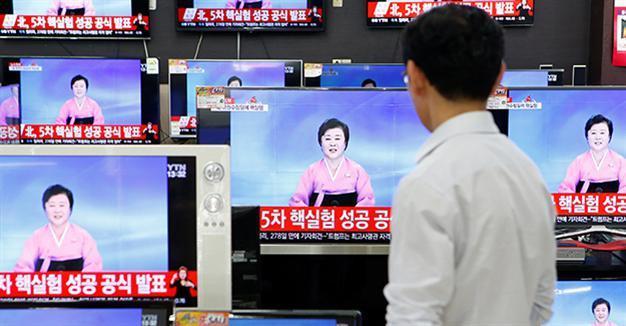North Korea claims 'successful' nuclear warhead test
SEOUL - Agence France-Presse

A sales assistant watches TV sets broadcasting a news report on North Korea's fifth nuclear test, in Seoul, South Korea, September 9, 2016. REUTERS photo
North Korea claimed on Sept. 9 it has successfully tested a nuclear warhead that could be mounted on a missile, drawing condemnation from the South over the "maniacal recklessness" of young ruler Kim Jong-Un.
The blast at the Punggye-ri nuclear site was the North's fifth and most powerful yet at 10 kilotons -- approaching the might of the bomb that devastated Hiroshima in 1945, experts in Seoul said.
Pyongyang's state media said the test, which comes after a series of ballistic missile launches that have drawn international condemnation and UN sanctions, had achieved its goal of being able to fit a miniaturized nuclear warhead on a rocket.
"Our nuclear scientists staged a nuclear explosion test on a newly developed nuclear warhead at the country's northern nuclear test site," a North Korean TV presenter said.
"Our... party sent a congratulatory message to our nuclear scientists... for conducting the successful nuclear warhead explosion test," said Ri Chun-Hee, a veteran who has delivered all the North's biggest announcements.
The news drew swift condemnation from US President Barack Obama who warned of "serious consequences" and said he had called the leaders of South Korea and Japan to confer over the crisis.
The South's President Park Geun-Hye spoke out against the "maniacal recklessness" of Kim, who since taking control after the death of his father in 2011 has carried out a series of purges and weapons tests designed to show strength and consolidate power.
"Kim Jong-Un's regime will only earn more sanctions and isolation... and such provocation will further accelerate its path to self-destruction," Park said, warning his obsession with creating a nuclear arsenal posed a grave challenge.
"We will step up pressure on the North by using all possible measures, including more, stronger sanctions on the North with the international community and at the UN Security Council," she said.
News of the test emerged when seismic monitors detected a 5.3-magnitude "artificial earthquake" early on Sept. 9 near the Punggye-ri nuclear site, where the last test took place in January.
"The 10-kiloton blast was nearly twice the fourth nuclear test and slightly less than the Hiroshima bombing, which was measured about 15 kilotons," said Kim Nam-Wook from the South's meteorological agency.
If Pyongyang can make a nuclear device small enough to fit on a warhead, and bolster the range and accuracy of its missiles, it might achieve its oft-stated aim of hitting US targets. But its claims to that in the past have been discounted.
Scientists will now attempt to analyse the blast to try to determine what kind of a breakthrough it represents, including whether it is a standard atomic bomb or a more powerful hydrogen, or thermonuclear, bomb.
But verifying the claim to have created a weapon-tipped missile will be difficult, said Melissa Hanham, a North Korea expert at the Middlebury Institute of International Studies.
"It's not really possible for us to verify that the test was of a compact warhead from the seismic data," she told AFP.
"We would need to see it tested on a missile like China did in the 1960s. Nobody wants to see that. There is no way they could do that test in a safe way, and it could easily start a war."
Japan condemned the move as "absolutely unacceptable" while the head of the UN atomic watchdog said it was a "clear violation" of numerous Security Council resolutions.
North Korea has been hit by five sets of United Nations sanctions since it first tested a nuclear device in 2006, but has insisted it will continue, arguing it faces an existential threat from US aggression.
A series of ballistic missile launches has also drawn intense criticism, with another three fired on Monday even as world powers gathered for a G20 meeting in China.
Nuclear tests are usually heralded by chatter among analysts about preparations at Punggye-ri, but this time observers were largely caught off guard, said Kim Jin-Moo from the Korea Institute for Defense Analyses.
"The test has been carefully planned out for months by the North to maximise the impact of the show of force to the international community," he told AFP.
The nuclear test is another slap in the face to the North's chief ally China which has been under pressure to rein in its increasingly embarrassing behavior.
China said on Sept. 9 it "firmly opposes" the test but it has limited room to manoeuvre, given its priority is to avoid a collapse of the regime that would create a crisis on its border and shift the balance of power on the Korean peninsula towards the US.
The US-Korea Institute at Johns Hopkins University, which had warned Thursday of "new activity" at Punggye-ri, said the latest development made plain that the US and South Korean strategy on restraining North Korea "has clearly failed".
"No one should be surprised that North Korea continues to conduct nuclear tests to enhance the capabilities of its growing arsenal. Nor should they expect China to solve this problem for the United States," said the institute's Joel Wit.
North Korea claimed its January test was of a miniaturised hydrogen bomb, which can be far more powerful than other nuclear devices.
But scientists say the estimated yield of around six kilotons was similar to the North's previous nuclear test in 2013, and far too low for a thermonuclear device. Initial indications from Monday's blast pointed in the same direction.
"What we can tell from the seismic waves so far is that this is likely not a thermonuclear test," said 38 North managing director Jenny Town.
"We are still in the preliminary stages but our analysts believe they tested a basic nuclear device not an advanced device," she said. "If we were looking at a thermonuclear test, we would see very different seismic waves."
